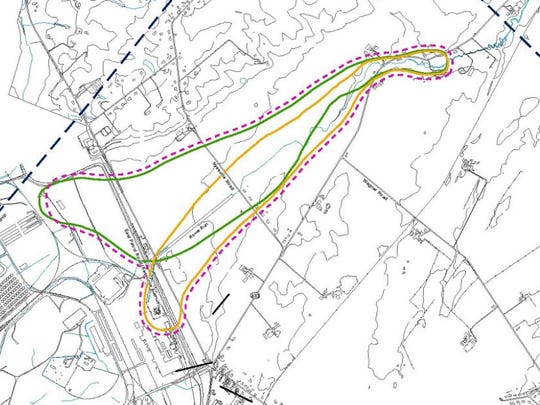Redding fire inspector Jeremy Stoke, died in the Carr fire
A rare “fire tornado” that barreled into Redding during the destructive Carr fire was responsible for killing a firefighter as he raced toward a neighborhood in flames, an investigation has found.
The twister may have been California’s strongest on record. It was roughly 1,000 feet in diameter and reached speeds of 136-165 mph, equivalent to a twister with a rating of EF-3 on the five-level Enhanced Fujita scale, the California Department of Forestry and Fire Protection said.
Not only is it believed to be responsible for the death of Redding fire inspector Jeremy Stoke, but the twister was also in the general area where Melody Bledsoe, 70, and her great-grandchildren, 5-year-old James Roberts and 4-year-old Emily Roberts, died in the blaze.
Stoke died after he became trapped in the fire tornado as he was heading south on Buenaventura Boulevard — the only path of escape for residents of the Redding neighborhoods of Land Park and Stanford Hills, which burned. Stoke had been heading to Land Park.
The tornado was highly unpredictable, resulting in fire behavior that surprised many highly experienced firefighters, the report said. Stoke was killed on the evening of July 26, when the fire suddenly transformed from a fuel-dominated fire to one that was driven and spread in part by wind generated from the fire itself.
Cal Fire also released dramatic video showing the tornado from a couple of perspectives. In a video shot from a helicopter, the immense twister can be seen glowing orange as gray smoke twists counterclockwise, surrounded by flames all around the vortex. In another video shot from a fire engine in Stanford Hills, a giant spinning vortex can be seen in the background.
The tornado was very destructive, causing wind damage to large oak trees, scouring the ground, damaging roofs and throwing high up into the air large steel power-line towers, vehicles and a steel shipping container, the Cal Fire report said. Peak temperatures in the tornado probably exceeded 2,700 degrees, and the strong winds caused the fire to burn all but the smallest vegetation, officials said.
The report said that, based on witness observations and other evidence, there were either several fire tornadoes that occurred in different locations and at different times, or one fire twister that formed, waned and waxed, resulting in several separate areas of damage.
Stoke was racing to Land Park as the rapidly moving blaze approached the Sacramento River from the west and threatened the neighborhoods east of the river.
By 6:38 p.m., firefighters ordered the evacuation of Buenaventura Boulevard. Five minutes later, firefighters determined that the fire was going to cross the river, and by 6:59 they observed smoke just northwest of Land Park.
A spot fire was seen west of Buenaventura Boulevard by firefighters at 7:17, and numerous other spot blazes were detected east of the Sacramento River. Minutes later, firefighters sought to evacuate residents and prepared to defend homes. It was around 7:23 that they began to see a large rotating plume of smoke just north of Land Park near Buenaventura Boulevard.
“The swirling winds at the base of the plume dramatically increased fire intensity. The rotating plume continued to intensify until it developed into a fire tornado,” the report said. “Winds dramatically increased near the fire tornado, and embers were lofted in many directions.”
At around 7:35, Stoke was dispatched from a fire station to Land Park just as the blaze reached the area. Three minutes later, a fire captain saw a fire tornado near Buenaventura Boulevard north of Land Park.
Stoke was last heard at 7:40 radioing a mayday, calling out for a water drop, and said he was getting burned over, the report said. He said he was in the middle of a road. Another firefighter called out to get Stoke’s location. There was no response.
The report also described the circumstances of the death of Don Ray Smith, 81, a bulldozer operator who was killed while battling the fire. Smith had been traveling downhill while trying to improve a pathway toward Spring Creek Reservoir that had been dozed over as a firebreak when he was overcome by flames.
A Cal Fire hand-crew strike team leader who assigned Smith to improve that pathway was unaware that a different dozer earlier that morning had abandoned that pathway because the area was too steep and overgrown with vegetation, and that the firebreak would be left incomplete because it was not viable.
Smith proceeded to improve the firebreak after meeting with the team leader around 5:30 p.m. But soon after, the fire had begun to increase in intensity, and winds were gaining strength from the northwest.
As Smith traveled down the existing dozer line downhill toward the reservoir, firefighters saw the blaze intensify. By 5:44, the fire jumped the dozer line. The team leader radioed to Smith several times to tell him to “get out of there,” the report said.
Two firefighters near the top of the dozer line tried to chase down the tractor, but couldn’t make it through as the flames strengthened. Finally, Smith responded back to the team leader by radio, saying “he could not get out because he was cut off by the fire, and he would push down instead.” He was heard around 5:50 p.m. asking for a water drop and saying he was trying to make a safety zone. That was his last message.
Smith’s fire shelter was found behind his seat, and his fire curtains were not deployed.
As of Thursday, the Carr fire had burned more than 214,000 acres and was 71% contained. The blaze has destroyed more than 1,000 residences and has been blamed for eight deaths. Besides Stoke, Smith, Bledsoe and her two grandchildren, another Redding resident, a Pacific Gas & Electric utility worker and a Cal Fire mechanic have also died in connection with the blaze.













